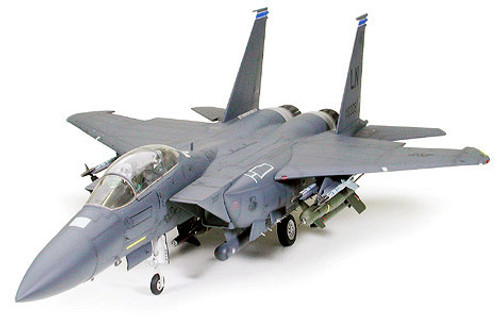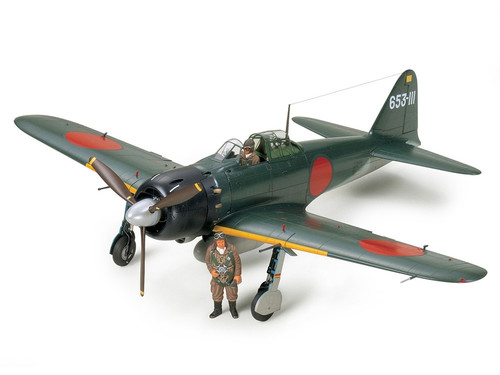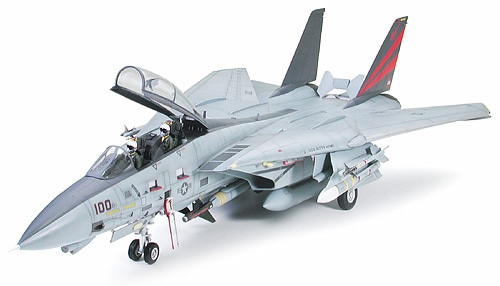Product Overview
Tamiya 60319
The Supermarine Spitfire is one of the most widely recognized fighters of WWII. Designed by R.J Mitchell, the Spitfire is known for its exploits during the Battle of Britain. Throughout the war, the Spitfire"s engine technology evolved to compete with the newer Axis aircrafts. As a result, there are numerous variants of the Spitfire, which served with distinction in the RAF as well as in the air forces of other countries. The Spitfire Mk. IX was produced as a result of the German Fw190A fighter, which were superior to the earlier production Spitfire Mk. V. The new Spitfire Mk. IX was equipped with a Merlin Series 60/70 engine and two-stage supercharger. This improved the performance of the aircraft and allowed it to match the Fw190A in battle. The production of the Spitfire Mk. IX continued until the end of WWII. The most common Spitfire featured the "C" universal wing, which could be equipped with four 20mm cannons or two 20mm cannons and four 7.7mm machine guns. Some of the Spitfires were also fitted with bomb racks to allow the aircraft to be used as a fighter-bomber.
1. Two types of fuel tanks (normal, flying stand)
2. Two types of filters (early / late model)
3. Two types of exhausts (early / late model)
4. Two types of cowlings (early / late model)
5. Two types of wing bulge (twin/single cannon)
6. Two types of wingtips (round, clipped)
7. Two types of rudder (round, pointed)
8. Two types of stabilizers (straight, horn)
Requires paint and assembly.3 kinds of markings including those for RAF's top ace Johnnie Johnson and a color finishing guide included This model is a totally new design and has nothing in common with any other Tamiya Supermarine Spitfire models Challenging model production technology limits, the engine cowlings have an amazing 0.4mm thickness to allow for a fully accurate scale representation of the engine. These cowlings can be installed and removed thanks to small magnets The C Wing with its two 20mm cannons and four 7.7mm machine guns is faithfully reproduced The details of the Rolls Royce Merlin engine including oil tanks, and supercharger have been faithfully remodeled Movable elevators, rudder, and ailerons. Flaps can be depicted in up or down position Landing gear parts included to depict either up or down position (interchangeable) Photo-etched parts to depict details such as wheel covers, cockpit details including ininstrument panel (early / late) and seat belts with or without pilot 1 seated and 1 standing pilot figure are included
The Supermarine Spitfire is one of the most widely recognized fighters of WWII. Designed by R.J Mitchell, the Spitfire is known for its exploits during the Battle of Britain. Throughout the war, the Spitfire"s engine technology evolved to compete with the newer Axis aircrafts. As a result, there are numerous variants of the Spitfire, which served with distinction in the RAF as well as in the air forces of other countries. The Spitfire Mk. IX was produced as a result of the German Fw190A fighter, which were superior to the earlier production Spitfire Mk. V. The new Spitfire Mk. IX was equipped with a Merlin Series 60/70 engine and two-stage supercharger. This improved the performance of the aircraft and allowed it to match the Fw190A in battle. The production of the Spitfire Mk. IX continued until the end of WWII. The most common Spitfire featured the "C" universal wing, which could be equipped with four 20mm cannons or two 20mm cannons and four 7.7mm machine guns. Some of the Spitfires were also fitted with bomb racks to allow the aircraft to be used as a fighter-bomber.
1. Two types of fuel tanks (normal, flying stand)
2. Two types of filters (early / late model)
3. Two types of exhausts (early / late model)
4. Two types of cowlings (early / late model)
5. Two types of wing bulge (twin/single cannon)
6. Two types of wingtips (round, clipped)
7. Two types of rudder (round, pointed)
8. Two types of stabilizers (straight, horn)
Requires paint and assembly.
Features:











